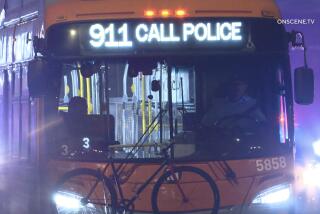Metro finishes retrofitting bus fleet with barriers to protect drivers from attacks

- Share via
Metro’s fleet of more than 2,000 buses has been fully retrofitted with barriers to protect drivers after a spate of violent attacks on public transit operators prompted an emergency action to expedite adding the fixtures earlier in 2024.
Metro launched its barrier installation project in 2022 and retrofitted a small number of buses in 2023. In April, after a bus driver was fatally stabbed, transit officials expedited plans to finish armoring the bulk of its 2,017 buses with protective tempered glass to shield drivers from passengers, becoming the first transit agency in the nation to do so.
Other regions, including Orange County and San Mateo County, have taken similar steps to install protective barriers as assaults on transit workers have increased, and the U.S. Department of Transportation directed transit agencies across the country to increase protections against front-line workers.
Metro’s emergency declaration allowed the agency to bypass policy and swiftly buy materials amid supply chain issues. Without the declaration, the process could have taken up to three years to complete given the amount of glass the agency needed to acquire, Metro’s senior manager of communications Maya Pogoda said.
Commuters descending to underground platforms for the A, B and D lines will enter into the testing ground for Metro’s 30-day pilot program.
Installation on the last bus was completed Monday. The barriers, which are constructed of steel and a laminated, low-reflectivity shatter-resistant glass, are intended to protect drivers from physical assaults such as punches and thrown objects. The agency used 55,000 square feet of glass.
“From this past April to September, operators were 58 percent less likely to be assaulted on buses with fully enclosed barriers. We’ve also seen a significant decline in spitting incidents,” Metro said in a statement.
Overall reported crimes against riders and staff across Metro’s system have been lower this year than last, according to the agency’s latest report from September. But on buses, recent data shows that the number of such crimes increased more than 12% from last year, largely due to a spike in reports of battery, homicides and assaults against transit operators. In May, bus drivers held a sickout in protest of the number of attacks on operators.
Metro leaders reiterated promises in September to improve safety after a second bus hijacking in six months and a fifth homicide of the year intensified concerns among riders and city officials.
L.A. wants a car-free Olympics but the $3.3 billion in transportation projects needed to make it happen are only 5% funded. Officials are looking to the next presidential administration for help.
“This is just one in the latest series of steps that Metro is taking to increase safety for its operators and passengers,” Pogoda said about the barrier installation.
Metro has also launched a weapons detection pilot program to spot concealed firearms using scanners on subway platforms reliant on AI technology.
The agency, which is offering free bus and train rides on New Year’s Eve until 3 a.m. Jan. 1, said its bus system has provided more than 222.7 million rides during the first 11 months of 2024.
More to Read
Sign up for Essential California
The most important California stories and recommendations in your inbox every morning.
You may occasionally receive promotional content from the Los Angeles Times.













